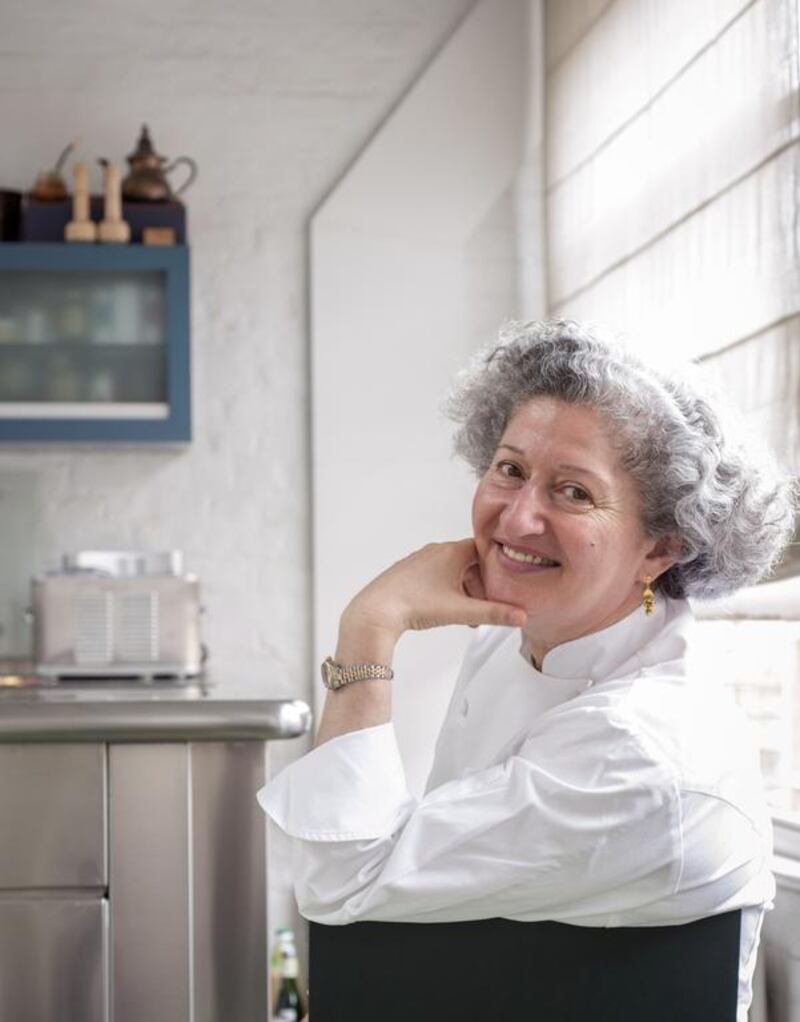“When I was in Gaziantep, Turkey, last year researching my cookbook, I visited a large hangar where this man was rolling ceviz sucugu, grape leather for walnut sausages, exactly like my aunt used to. When I saw him spread that great jelly, I was taken back to summers at home in Mashta el-Helou [Syria]. A fantastic moment, so touching,” reminisces Anissa Helou, the London-based Lebanese-Syrian food writer, journalist, broadcaster and blogger, on one of many memories recorded in her ninth cookbook, Levant: Recipes and Memories from the Middle East, recently published by HarperCollins.
Levant brings together 150 traditional recipes that Helou gathered from her upbringing and travels in Syria, Lebanon, Palestine, Jordan,Turkey and Iran, which she calls the mother of all cuisines.
Peppered with memoirs from her culinary journey, Helou steers away from categorising the recipes by the norm of starters, mains and the like. Instead, she draws the dishes together, quite cleverly, through the differing social structure of family, farm, souqs, restaurants, bakeries and sweet-makers. Her main goal: to record the food traditions of countries that are changing beyond recognition and are at risk of disappearing.
“It was going to be a travel memoir and cookbook with photos, which would have been different to what I have done before, but the photo-grapher had a break-in and he lost the photographs including lots from Syria and so they [the publishers] decided to go without photography.
“For me, food is culture. I approach it quite differently from just cooking. As much as I am interested in perfecting recipes and a refined palate, what interests me the most is recording dying traditions for the next generation who may not be as involved in food preparation. So it’s a continuous research that’s more an intellectual, cultural, historical and social pursuit, than commercial.”
While there is a general perception that the cuisines in Lebanon, Jordan, Palestine and Syria are relatively similar, Helou paints a good picture of the variances.
She also dispels the myth that Levantine cuisine is meat-heavy, explaining that meat is almost always used as an adjunct to vegetables, evident in the prevalence of vegetarian stews and mezzes overflowing with dips, salads and savoury pastries.
These countries are bursting with fruit and vegetables that people eat naturally, playing homage to seasonality. It is only in grilled dishes such as kibbeh or kofta that meat takes centre stage.
“Lebanon is fresh with simple flavours that favour tartness and savoury. In Turkey and Syria, you have more complexity, and also in Iran, you have the mixture of meat with fruit, sweet with sour. In Jordan and Palestine, it’s more homely and they take a little spice.
“Iran is quite different. Iran is the only country where rice is king, whereas burghul and freekeh are the staple elsewhere. Dishes from country to country may have the same texture because the ingredients are similar, but the taste and flavour are different because the preparation is different,” Helou explains.
Home cooks will rejoice in the simplicity of most recipes as Helou favours an easy life in the kitchen, despite her 1,500-strong cookbook collection. The exceptions are more elaborate and time-consuming dishes such as stuffed vegetables – one of her favourites is the Swiss chard version or the kibbeh bil-saniyeh pie.
On the sweet front, Helou loves karabij pistachio cookies with dried root, using desiccated wood to produce something extraordinary.
“I only cook when I am testing or for friends. Otherwise I have leftovers. I make a lot of salads, probably my favourite food. I eat them everyday, even in the winter. My secret for looking healthy is olive oil.”
What about olive oil’s lower smoke point, though? “No matter what you tell people in Lebanon and Syria, they will continue to use olive oil but no one fries in it anymore. I fry with rapeseed or sunflower oil. But for other cooking methods I will use very good olive oil,” she says.
Cookbooks aside, Helou has recently branched into the world of restaurants in London with the opening of Koshari Street, an Egyptian- inspired street food experience serving the country’s famous spicy rice dish. With plans further down the line to expand globally, we may just see the concept pop up in the UAE.
• Anissa Helou’s latest cookbook, priced at Dh130, is available from the Kinokuniya bookstore in Dubai. Visit www.anissas.com
Samantha Wood is the founder of the impartial restaurant review blog www.foodiva.net
Here are two recipes from Anissa Helou’s cookbook
Chicken Fatteh
Fattet Djej in Arabic
Fatta means “to break into pieces” in Arabic, and fatteh (also known as fatta depending on the country or the accent) describes a composite dish made up of pieces of toasted pita topped with meat, vegetables and/or pulses, covered with yogurt and garnished with toasted pine nuts. The dish is typical for street breakfast in Lebanon, although it is eaten at other times of the day, too, and there are many variations depending on the time it is served, the region or the family. Here I give a version of the dish using chicken, but you can easily make it with lamb instead. Replace the chicken with a shoulder of lamb, skinned and trimmed of fat, or 1kg (2lb 2oz) neck fillets, and prepare it in the same way, bearing in mind that you may have to cook the lamb for a little longer. The traditional method is to use dried chickpeas that you soak and then cook with the meat, but I like to simplify things if I can and I now use ready-cooked chickpeas that are preserved in brine in a jar without any preservatives. All I do is rinse them well before adding them to the stock and cooked meat to heat them through. In that time, they absorb the taste of the stock and you won’t know the difference between the chickpeas you’ve cooked from scratch and the ready-cooked ones.
Serves 4
Ingredients
1 medium-sized chicken (about 1.5kg/3lb 5oz)
1 cinnamon stick
Coarse sea salt
1 large round pita bread, opened at the seams (I substituted toasted lavash for pita, but you can use any flat bread as long as it’s not too thin) 3 tbsp unsalted butter
100g (3 oz) pine nuts
1 x 675g jar of chickpeas preserved in salted water (475g/16 oz drained weight), rinsed under cold water and drained
1 garlic clove, peeled and crushed
A handful of mint leaves, crushed with the garlic (optional)
1kg (2lb 2oz) plain yogurt
Method
Put the chicken in a large saucepan, add 1.25 litres (2 pints) of water and place over a medium heat. As the water comes to the boil, skim any scum that rises to the surface. Once it has come to the boil, reduce the heat, then add the cinnamon stick and 1 tablespoon of salt and cover the pan with a lid. Let the stock bubble gently for 45 minutes or until the chicken is cooked.
Meanwhile, preheat the oven to 220°C (425°F); gas mark 7.
Toast the bread in the oven until golden brown, then remove and allow to cool. Spread the pine nuts on a baking sheet and toast them in the oven at the same time for 5-7 minutes or until golden brown.
Remove the chicken from the saucepan and strain the stock into a clean pan. Then skin the chicken and take the meat off the bone before cutting it into bite-sized pieces. Add these to the stock with the chickpeas and place over a low heat.
Mix the crushed garlic (and mint, if using) into the yogurt and add salt to taste.
Break the bread into bite-sized pieces and spread over the bottom of a serving dish. Spread the hot chicken pieces and chickpeas over the bread. (You can, at this stage, add a little stock, although I prefer not to because I like the bread to stay crisp.) Cover with the yogurt and garnish with the toasted pine nuts. Serve immediately.
Fattoush from Las Salinas, Lebanon
A rather nondescript restaurant by the sea in Tyre in the south of Lebanon, Las Salinas may not be attractive but the food is definitely worth the detour. It serves incredibly fresh fish, caught not too far from the restaurant. Its fattoush, the salad of choice to serve with fish, is quite different from any I have had elsewhere. Instead of using lettuce with the herbs, as they do in some restaurants, the chefs add very finely shredded cabbage, which makes for an even more crisp salad.
The salad can do without bread, which is preferable when served with a dish such as fatteh.
Serves 4
Ingredients
1 medium-sized round pita bread
3 tbsp ground sumac
6 tbsp extra-virgin olive oil
1 medium-sized pointed spring cabbage (about 400g/14oz), trimmed and very finely shredded
100g (3 oz) spring onions (about 1 bunch), trimmed and thinly sliced
300g (11oz) small cucumbers (or large if you cannot find the Middle Eastern variety), sliced into medium-thin semicircles
300g (11oz) cherry tomatoes, halved or quartered depending on their size
200g (7oz) flat-leaf parsley (about 1 bunch), most of the stalk discarded, coarsely chopped
100g (3 oz) mint (about 1 bunch), leaves picked from the stalks and coarsely chopped
100g (3 oz) purslane (about 1 bunch), leaves picked from the stalks
Sea salt
Method
Preheat the grill to high or the oven to 200°C (400°F), gas mark 6.
Tear the pita bread open at the seams and toast it under the grill or in the oven until golden brown. Place it on a wire rack to cool.
Break the toasted bread into bite-sized pieces and put in a mixing bowl.
Sprinkle with the sumac, add the olive oil and mix well so that the bread is thoroughly coated.
Put the shredded cabbage in a salad bowl and add the rest of the salad ingredients with a little salt.
Toss gently together and taste, adjusting the seasoning if necessary.
Mix in the toasted bread. Serve immediately.






